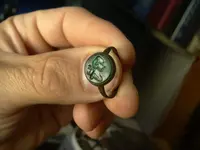VThistorybuff
Jr. Member
Found this brass & glass ring in the yard of a 200 year old house in VT. The site has yielded items from as far back as the 1700s (eg, 1751 KGII halfpenny; pewter buttons & spoons) but mostly 1800s. The ring was about 10?-12? down. It?s crudely made. Nothing is symmetrical, not even the facets on the glass jewel. The patina seems quite advanced to me. The only other ring I?ve been able to find online that bears any similarity to mine is one that?s purported to be a 1600s fur trade ring from upstate NY (see pic). So my question is whether mine could also be a fur trade ring, even if from a later period. Thoughts?
Attachments
-
 123BC66A-F403-4216-88C4-22595A43A107.webp57.8 KB · Views: 191
123BC66A-F403-4216-88C4-22595A43A107.webp57.8 KB · Views: 191 -
 2004A82A-B19E-4764-8927-924AEE812D48.webp45 KB · Views: 192
2004A82A-B19E-4764-8927-924AEE812D48.webp45 KB · Views: 192 -
 91311136-4D42-48EA-9A8A-688C914F488A.webp56.4 KB · Views: 199
91311136-4D42-48EA-9A8A-688C914F488A.webp56.4 KB · Views: 199 -
 C6B9EC08-07FA-44E0-BB61-61C407A7D981.webp75.8 KB · Views: 162
C6B9EC08-07FA-44E0-BB61-61C407A7D981.webp75.8 KB · Views: 162 -
 3843296D-FE24-4B02-9A8E-DD6B01A8D197.webp68.7 KB · Views: 206
3843296D-FE24-4B02-9A8E-DD6B01A8D197.webp68.7 KB · Views: 206 -
 2623E071-DB4C-4779-9BD6-40E1B9ED5E8E.webp85.7 KB · Views: 168
2623E071-DB4C-4779-9BD6-40E1B9ED5E8E.webp85.7 KB · Views: 168
Upvote
1






